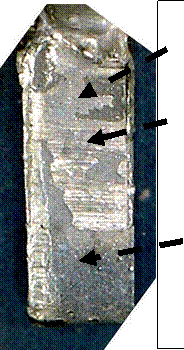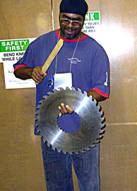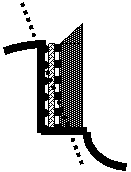 Loading... Please wait...
Loading... Please wait...(800) 346-8274
Free Ground Shipping on Orders over $150!
Over 23,000 Items Discounts up to 40% off Retail
Bad Surface and Gumming
Our Newsletter
- Home
- Technical Info
- Brazing Carbide
- Bad Surface and Gumming
Bad Surface and Gumming
Chrome Plating Not Gummed Out of Notch
These are the tips we broke out of a saw. Two that were side ground and one that had just been brazed into the saw and not ground. Since they started using the 5/16 X .100 they are getting some tip loss. Sometimes it is two or three tips per saw and others it is more.
|
|
 |
The gray color on top of the braze alloy is something that came off the saw plate. The areas with horizontal lines and a golden color are braze alloy.
The areas below the braze alloy are tungsten carbide.
|
|
Here are 50x pictures taken using our Proscope. |
||
|
|
|
Note: We sometimes see horizontal lines in the braze alloy in tip loss situations such as this. The horizontal lines have, in the past, been coincident with brazing to laser cut plates that were either not gummed out properly or not gummed out at all.
I sent these pictures and some samples to Dave Bell and here is his reply:
“I have some preliminary information (and as a result, some questions) regarding the failure. The single tip that came off of the blade failed near the steel/braze interface. It is a very unusual failure. The majority of the tip surface has steel attached to it (meaning that a thin layer of steel separated from the blade). I also found a pure chromium layer between the steel and the braze alloy. Is it possible that the blade was chromium plated prior to brazing, or maybe it was a reworked blade that did not have the chromium layer removed prior to rework? Please tell me all you know about this blade (even if you think it is insignificant).”
Dave thought the direction of the shear was unusual because the tip failed in testing. The saw blade was tested by hitting it with a stick. This is a good test but it does not deliver impact the same way that a saw mill does.

Discovery
“This mill buys chrome plated saw plate. These plates are flash chromed.” The chrome surface is designed as a wear surface. It is not designed to have the kind of peel or tensile strength needed to hold a saw tip on.”
Conclusion 1 – Gray Layer
Dave Bell saw the gray color on top of the braze alloy and identified it as chrome using a scanning electron microscope. "The chromium appears to be the culprit here. The chromium must be completely removed from the seat pocket prior to brazing.
"I didn’t see what you were talking about originally but Norm Brown, from Simonds, pointed out the light gray color on top of the braze alloy. The saw plate was not gummed well enough to remove all the chrome from the pocket before brazing. Given the thickness of the layer of chrome and the thickness of metal removed by gumming the question might be raised as to whether the notches were gummed at all." Dave Bell
Conclusion 2 – Bare Carbide
The carbide surface, at least in some areas, did not respond well to the treatment. This is evidenced by the fact that many carbide grains were visible in these areas. As a result, the braze did not adhere to the carbide in these areas. Here, again, is how the parts were tested. A stick is used to strike the tips. The idea is to try to duplicate the impact the saw blade sees in actual sue. Instead the best you can do is to strike the tip in a direction that only roughly approximates what happens in a mill. In actual practice the tip is pretty well struck from the top and not the front in this test. You really have a sandwich here. You have saw plate on the left. Next you have the dotted line which is the chrome plating. After that is the braze alloy. Some carbide has a surface treatment to make the carbide wet well. Finally you have the carbide.
 |
 |
 |
This sandwich is designed to hold the tip, in place against a direct hit and to cushion the tip against impact. In this case the impact was applied from a different direction. It is somewhat like the difference between chopping a log and splitting a piece of wood. It looks like the tip failed along the line shown.
|
|
|









